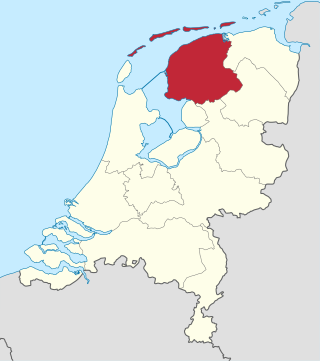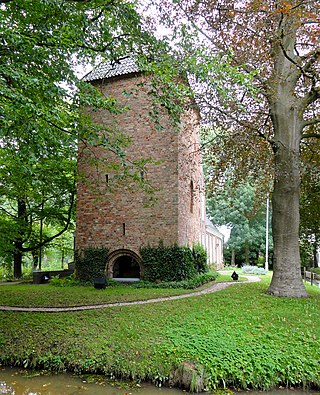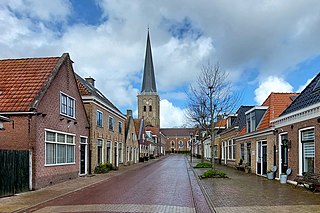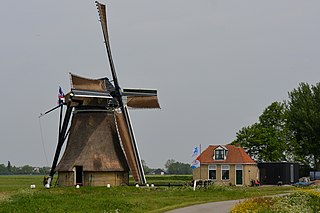Related Research Articles

Friesland, historically and traditionally known as Frisia, named after the Frisians, is a province of the Netherlands located in the country's northern part. It is situated west of Groningen, northwest of Drenthe and Overijssel, north of Flevoland, northeast of North Holland, and south of the Wadden Sea. As of January 2023, the province had a population of about 660,000, and a total area of 5,753 km2 (2,221 sq mi).

Leeuwarden is a city and municipality in Friesland, Netherlands, with a population of 127,073 (2023). It is the provincial capital and seat of the Provincial Council of Friesland.

Dantumadiel is a municipality in the province of Friesland in the Netherlands. Dantumadiel is a rural municipality characterized by economic activity and agriculture.
Ygo Gales Galama was a 15th-century Frisian warlord and Galama-patriarch.

Coert or Court Lambertus van Beyma, son of Julius Matthijs van Beyma and Fokel Helena van Burmania, was a public notary and auctioneer, delegate and representative of the Frisian States, and the radical leader of the Frisian patriots. He was the initiator of a Frisian coup and spent seven years in exile in north-western France. On his return to the Netherlands in 1795, he became a delegate to the National Assembly of the newly established Batavian Republic.

A stins is a former stronghold or villa in the province of Friesland, the Netherlands. Many stinsen carry the name "state".

The Vetkopers and Schieringers were two opposing Frisian factional parties from the medieval period. They were responsible for a civil war that lasted for over a century (1350–1498) and which eventually led to the end of the so-called "Frisian freedom".

Tzum is a village in Waadhoeke municipality in the province of Friesland, the Netherlands. It had a population of around 1,164 in January 2014. Tzum is known for its 72 metre tall church tower.

Rinsumageast is a village in the Dantumadiel municipality of Friesland, the Netherlands. It had a population of around 965 in 2017.
A grietenij was a municipal district, a forerunner to the gemeente or municipality in Frisia, particularly in Friesland, and also in the city Groningen which are now a part of the Netherlands. After the Saxon occupation, from about 1498 until 1851, there were a total of 30 grietenijen in Friesland and 11 cities.

Menaam is a village in Waadhoeke municipality in the province of Friesland, the Netherlands. It had a population of around 2,609 citizens in January 2017. Before 2018, the village was part of the Menameradiel municipality.

The Frisian–Frankish wars were a series of conflicts between the Frankish Empire and the Frisian kingdom in the 7th and 8th centuries.

Almenum is a historic locality in the northern Netherlands, near Midlum, Friesland the site of the first Christian church in Friesland. Saint Boniface set up a local church in the locality in 754. The location of the church is on the Terp of Almenum, a mound of earth about five meters high. Almenum is named after the place where someone called "Allaman" lived. The -um suffix is derived from the West Frisian word "hiem" meaning "home". An alternative explanation for the name of the locality is that it originally meant common lands for grazing cattle. In Icelandic this kind of land still uses the term "almenningurheim".
Bernhardus "Bernhard" van Haersma Buma was a Dutch politician and writer. As politician he was part of Christelijk-Historische Unie (CHU) and later CDA. He was mayor of Workum and Sneek.

The States of Friesland were the sovereign body that governed the province of Friesland under the Dutch Republic. They were formed in 1580 after the former Lordship of Frisia acceded to the Union of Utrecht and became one of the Seven United Netherlands. The Frisian stadtholder was their "First Servant". The board of Gedeputeerde Staten was the executive of the province when the States were not in session. The States of Friesland were abolished after the Batavian Revolution of 1795 when the Batavian Republic was founded. They were resurrected in name in the form of the Provincial States of Friesland under the Constitution of the Kingdom of the Netherlands.

Visvliet is a village in the Dutch province of Groningen. It is part of the municipality of Westerkwartier, and is located near the river Lauwers, the border between Friesland and Groningen.

De Puollen is a hamlet in the Dutch municipality of Waadhoeke in the province of Friesland. It is located to the south of Deinum and on the east side of Dronryp, of which it is a part administratively. The Puolfeart flows through the hamlet and its surrounding polder. This canal forms the heart of the hamlet, which consists of scattered residences on the Puoldyk.
De Vlaren or Vlaren is a hamlet in the Dutch municipality of Waadhoeke in the province of Friesland. It is located northwest of Lollum and southwest of Tzum, of which it is a part administratively. The residences are located on the Lollumerweg as a cluster of loose farms near the Baymerleane.

Kie is a hamlet in the Dutch municipality of Waadhoeke in the province of Friesland. It is located northwest of Hitzum, southeast of Herbaijum and just southwest of Franeker, of which it is a part administratively. The settlement of the hamlet is located on a road of the same name. The Van Harinxma Canal, formerly called the Harlingertrekvaart, flows north of Kie.
References
- ↑ Engelsma, Eise (21 June 2010). De Grote Friese Oorlog. Partijstrijd in de Friese landen : 1413 - 1422 (PDF). p. 9. Retrieved 30 June 2019.
- 1 2 3 4 5 6 7 Mol, Hans (January 2022), "Personal Violence in the Frisian Countryside", Communities, Environment and Regulation in the Premodern World, Comparative Rural History of the North Sea Area, vol. 20, Turnhout, Belgium: Brepols Publishers, pp. 263–288, doi:10.1484/m.corn-eb.5.129381, ISBN 978-2-503-59446-0 , retrieved 2023-03-26
- 1 2 3 "Systeem van elf steden en dertig grietenijen was uniek in Europa". Leeuwarder Courant. Retrieved 29 June 2020.
- 1 2 Mol, Hans (2022). The Frisian Popular Militias between 1480 and 1560. Amsterdam University Press. ISBN 978-94-6372-367-1. OCLC 1366294100.
- 1 2 Mol, Johannes (2020). Geweld op het Friese platteland 1524-1530. OCLC 1367139456.
- ↑ Buylaert, Frederik (2019-06-24). "Hans Mol, De Friese volkslegers tussen 1480 en 1560 (met een editie van de Monsterlijsten van Friesland 1552 en Ameland 1558, door P.L.G. van der Meer en J.A. Mol)". BMGN - Low Countries Historical Review. 134 (2). doi: 10.18352/bmgn-lchr.10719 . ISSN 2211-2898.
- ↑ Hendriks, Albert (2022-09-01). "Leeuwarden". Friesland Holland Travel. Retrieved 2023-03-28.
- ↑ "Noordelijk Oostergo. Ferwerderadeel". Digital Library for Dutch Literature (in Dutch). 1981. Retrieved 29 June 2020.
- 1 2 3 contributor., Brouwers, Ype, 1949- editor. Broersma, Rudolf J. Genealogysk Jierboek 2015. ISBN 978-94-92176-16-5. OCLC 1112368113.
{{cite book}}:|last=has generic name (help)CS1 maint: multiple names: authors list (link) CS1 maint: numeric names: authors list (link) - 1 2 3 4 A., Faber, J. (1973). Drie eeuwen Friesland : Economische en sociale ontwikkelingen van 1500 tot 1800. De Tille. OCLC 463181727.
{{cite book}}: CS1 maint: multiple names: authors list (link)